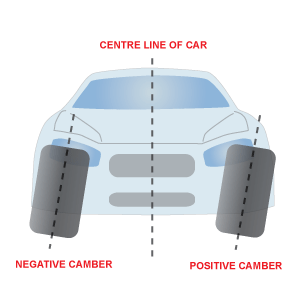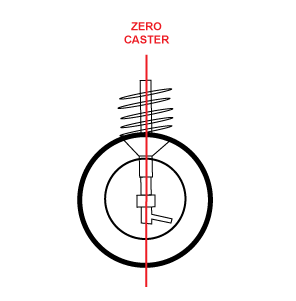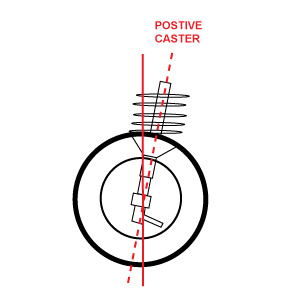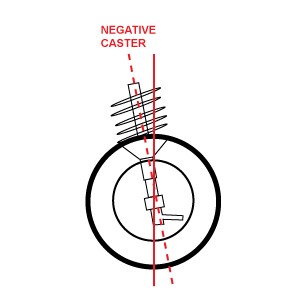Tech Info > Camber & Caster
Camber: the inward or outward tilt of the wheel assembly as viewed from the front of the vehicle. This angle is measured from a true vertical line, perpendicular to the ground.
Zero camber: the tire/wheel assembly is in the exact vertical position or perpendicular to the ground.
Positive camber: the tire/wheel assembly is tilted outward from the engine at the top.
Negative camber: the tire/wheel assembly is tilted inward toward the engine at the top.
Causes of Camber Change
- Ride height variations from factory specifications.
- Raising or lowering the suspension or changing the total weight of the vehicle
- Suspension sag as a vehicle ages or is damaged by excessive vehicle loading causing springs to weaken
- Center support or crossmember may also sag
- Raising or lowering the suspension or changing the total weight of the vehicle
*Before starting alignment consult a ride height specification book and attempt to adjust if specifications are not correct.
Effects of Positive Camber
- Slight positive camber creates dynamic loading allowing the tire to run relatively flat against the road surface.
- Positive camber directs the shock and weight load of the vehicle onto the larger inner wheel bearing and inboard portion of the spindle rather than the outboard bearing.
- Moderate positive camber allows for longer bearing life, less likely sudden load failure and in turn easier steering.
- Excessive positive camber wears the outside of the tire and may cause suspension parts such as wheel bearings and spindles to wear prematurely
Effects of Negative Camber
- A setting of 1/2° negative on both sides will improve cornering while having little effect on tire life.
- Negative camber compensates for the slight positive camber change of the outside tire as a vehicle rolls, therefore allowing flatter tire contact during cornering.
- Excessive negative camber wears the inside of the tire and, as with positive camber, can result in wear and stress on suspension parts.
Caster: the angle between the vehicle's steering axis and a vertical line, as viewed from the side. This line is created by extending a line through the upper and lower steering knuckle pivot points. For vehicles with front control arms, visualize a line extending through the upper and lower ball joints. On strut equipped vehicles, the line extends through the lower ball joint to the center of the upper strut mount. Most importantly caster is always viewed from the side of the vehicle. When the two points are straight up and down from each other, the caster is zero. When the upper pivot is forward of the lower pivot point, caster is negative. If the upper pivot point is rearward of the lower pivot point, caster is positive. Typically a maximum side to side variation of ±.5° is recommended on most vehicles. Caster is used as a directional control for stability and steering returnability, not as a normal tire wearing angle.
Front of Vehicle Caster Effect
Caster effect allows the load of the vehicle to be "carried" through the steering axis line formed on the upper and lower pivot points. Positive caster creates directional stability as the tire is being pulled along by the load which is projected in front of the center of the tire contact area. This results in positive caster (point of load ahead of the point of contact) and the vehicle becomes harder to steer away from the straight ahead position. With positive caster, the tire will continue to go straight as road surface variations have a minimal effect on the tire. With a negative caster condition, the projected steering axis point of load is behind the tire point of contact, and the vehicle will have a tendency to be easier to steer but will lack directional stability. A vehicle with negative caster is easily affected by any road surface variation such as small road abnormalities or bumps. With the point of load pushing the tire along (negative caster), any bumps or road irregularities have a tendency to immediately affect directional stability and vehicle handling.
Effects of Positive Caster
Positive caster promotes directional stability and most vehicles have some positive caster specified, however, excessive positive caster can result in two problems. Firstly, excessive caster causes a high level of road shock to be transferred to the driver when the vehicle hits a bump or other road irregularity. Secondly, a tire/wheel assembly with positive caster tends to toe inward as the vehicle is driven. Should one side have more positive caster than the other, the vehicle will toe inward with more force than the other side. This results in a lead or drift to the side with the least amount of positive caster.
Effects of Caster on Tire Wear
Vehicles set with a substantial amount of caster cause the spindle to travel in a vertical arc, making it to move up and down and raise and lower the wheels as the steering wheel is turned. This causes the camber to change. With a high level of positive caster, the tires will show wear on their shoulders especially when driven at low speeds in tight turns. In high speed cornering, the vehicle tends to continue straight ahead when the steering is initially turned. This, combined with the amount of camber change that takes place when a spindle travels through its arc of travel, results in the shoulders of the tires being scrubbed and worn. For example, the right front wheel's camber will become negative while the outside edge of the tire is scrubbed because of the vehicle's momentum to go straight. A setting caster of more than +2.5° will cause scrub problems on some vehicles.
Call or email us to get our price list or to get set up for ONLINE ORDERING and price checks.




